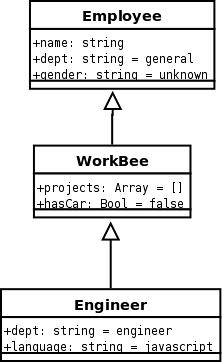JS中的phototype是JS中比较难理解的一个部分
本文基于下面几个知识点:
1 原型法设计模式
在.Net中可以使用clone()来实现原型法
原型法的主要思想是,现在有1个类A,我想要创建一个类B,这个类是以A为原型的,并且能进行扩展。我们称B的原型为A。
2 javascript的方法可以分为三类:
a 类方法
b 对象方法
c 原型方法
例子:
{
this.name=name;
//对象方法
this.Introduce=function(){
alert("My name is "+this.name);
}
}
//类方法
People.Run=function(){
alert("I can run");
}
//原型方法
People.prototype.IntroduceChinese=function(){
alert("我的名字是"+this.name);
}
//测试
var p1=new People("Windking");
p1.Introduce();
People.Run();
p1.IntroduceChinese();
3 obj1.func.call(obj)方法
意思是将obj看成obj1,调用func方法
好了,下面一个一个问题解决:
prototype是什么含义?
javascript中的每个对象都有prototype属性,Javascript中对象的prototype属性的解释是:返回对象类型原型的引用。
A.prototype = new B();
理解prototype不应把它和继承混淆。A的prototype为B的一个实例,可以理解A将B中的方法和属性全部克隆了一遍。A能使用B的方法和属性。这里强调的是克隆而不是继承。可以出现这种情况:A的prototype是B的实例,同时B的prototype也是A的实例。
先看一个实验的例子:
{
this.showMsg = function()
{
alert("baseClass::showMsg");
}
}
function extendClass()
{
}
extendClass.prototype = new baseClass();
var instance = new extendClass();
instance.showMsg(); // 显示baseClass::showMsg
我们首先定义了baseClass类,然后我们要定义extentClass,但是我们打算以baseClass的一个实例为原型,来克隆的extendClass也同时包含showMsg这个对象方法。
extendClass.prototype = new baseClass()就可以阅读为:extendClass是以baseClass的一个实例为原型克隆创建的。
那么就会有一个问题,如果extendClass中本身包含有一个与baseClass的方法同名的方法会怎么样?
下面是扩展实验2:
{
this.showMsg = function()
{
alert("baseClass::showMsg");
}
}
function extendClass()
{
this.showMsg =function ()
{
alert("extendClass::showMsg");
}
}
extendClass.prototype = new baseClass();
var instance = new extendClass();
instance.showMsg();//显示extendClass::showMsg
实验证明:函数运行时会先去本体的函数中去找,如果找到则运行,找不到则去prototype中寻找函数。或者可以理解为prototype不会克隆同名函数。
那么又会有一个新的问题:
如果我想使用extendClass的一个实例instance调用baseClass的对象方法showMsg怎么办?
答案是可以使用call:
var instance = new extendClass();
var baseinstance = new baseClass();
baseinstance.showMsg.call(instance);//显示baseClass::showMsg
这里的baseinstance.showMsg.call(instance);阅读为“将instance当做baseinstance来调用,调用它的对象方法showMsg”
好了,这里可能有人会问,为什么不用baseClass.showMsg.call(instance);
这就是对象方法和类方法的区别,我们想调用的是baseClass的对象方法
最后,下面这个代码如果理解清晰,那么这篇文章说的就已经理解了:
function baseClass()
{
this.showMsg = function()
{
alert("baseClass::showMsg");
}
this.baseShowMsg = function()
{
alert("baseClass::baseShowMsg");
}
}
baseClass.showMsg = function()
{
alert("baseClass::showMsg static");
}
function extendClass()
{
this.showMsg =function ()
{
alert("extendClass::showMsg");
}
}
extendClass.showMsg = function()
{
alert("extendClass::showMsg static")
}
extendClass.prototype = new baseClass();
var instance = new extendClass();
instance.showMsg(); //显示extendClass::showMsg
instance.baseShowMsg(); //显示baseClass::baseShowMsg
instance.showMsg(); //显示extendClass::showMsg
baseClass.showMsg.call(instance);//显示baseClass::showMsg static
var baseinstance = new baseClass();
baseinstance.showMsg.call(instance);//显示baseClass::showMsg
</script>
起由
最近在做一个项目,里面大量地使用 javascript 作为页面的动态生成脚本, 使用 json 与服务器进行通信. 在读之前遗留的代码时, 经常会弄不清楚, 作用域, this关键字在当前context下的指向等,于是便开始专门学习了 相关的知识,记录下来与大家分享.
下面的内容中会有一些代码,建议大家也去尝试修改和理解,这样更容易掌握. 点击 这儿 下载所涉及到的源码.
prototype
javascript 是一种 prototype based programming 的语言, 而与我们通常的 class based programming 有很大 的区别,我列举重要的几点如下:
- 函数是first class object, 也就是说函数与对象具有相同的语言地位
- 没有类,只有对象
- 函数也是一种对象,所谓的函数对象
- 对象是按 引用 来传递的
那么这种 prototype based programming 的语言如何实现继承呢(OO的一大基本要素), 这也便是 prototype 的由来.
看下面的代码片断:
function foo(a, b, c)
{
return a*b*c;
}
alert(foo.length);
alert(typeof foo.constructor);
alert(typeof foo.call);
alert(typeof foo.apply);
alert(typeof foo.prototype);
对于上面的代码,用浏览器运行后你会发现:
- length: 提供的是函数的参数个数
- prototype: 是一个object
- 其它三个都是function
而对于任何一个函数的声明,它都将会具有上面所述的5个property(方法或者属性).
下面我们主要看下prototype.
// prototype
function Person(name, gender)
{
this.name = name;
this.gender = gender;
this.whoAreYou = function(){//这个也是所谓的closure, 内部函数可以访问外部函数的变量
var res = "I'm " + this.name + " and I'm a " + this.gender +".";
return res;
};
}
// 那么在由Person创建的对象便具有了下面的几个属性
Person.prototype.age = 24;
Person.prototype.getAge = function(){
return this.age;
};
flag = true;
if (flag)
{
var fun = new Person("Tower", "male");
alert(fun.name);
alert(fun.gender);
alert(fun.whoAreYou());
alert(fun.getAge());
}
Person.prototype.salary = 10000;
Person.prototype.getSalary = function(){
return this.name + " can earn about " + this.salary + "RMB each month." ;
};
// 下面就是最神奇的地方, 我们改变了Person的prototype,而这个改变是在创建fun之后
// 而这个改变使得fun也具有了相同的属性和方法
// 继承的意味即此
if (flag)
{
alert(fun.getSalary());
alert(fun.constructor.prototype.age);//而这个相当于你直接调用 Person.prototype.age
alert(Person.prototype.age);
}
从上面的示例中我们可以发现,对于prototype的方法或者属性,我们可以 动态地 增加, 而由其创建的 对象自动会 继承 相关的方法和属性.
另外,每个对象都有一个 constructor 属性,用于指向创建其的函数对象,如上例中的 fun.constructor 指向的 就是 Person.
那么一个疑问就自然产生了, 函数对象中自身声明的方法和属性与prototype声明的对象有什么差别?
有下面几个差别:
- 自身声明的方法和属性是 静态的, 也就是说你在声明后,试图再去增加新的方法或者修改已有的方法,并不会 对由其创建的对象产生影响, 也即 继承 失败
- 而prototype可以动态地增加新的方法或者修改已有的方法, 从而是 动态的 ,一旦 父函数对象 声明了相关 的prototype属性,由其创建的对象会 自动继承 这些prototype的属性.
继续上面的例子:
flag = true;
// 函数内部声明的方法是静态的,无法传递的
Person.school = "ISCAS";
Person.whoAreYou = function(){
return "zhutao";
};//动态更改声明期的方法,并不会影响由其创建的对象的方法, 即所谓的 静态
if (flag)
{
alert(Person.school);
alert(fun.school);//输出的是 "undefined"
alert(Person.whoAreYou()); //输出 zhutao
alert(fun.whoAreYou()); // I'm Tower and I'm a male.
}
Person.prototype.getSalary = function(){
return "I can earn 1000000 USD";
};
if (flag)
{
alert(fun.getSalary());//已经继承了改变, 即所谓的 动态
}
既然有函数对象本身的属性, 也有prototype的属性, 那么是由其创建的对象是如何搜索相应的属性的呢?
基本是按照下面的流程和顺序来进行.
- 先去搜索函数对象本身的属性,如果找到立即执行
- 如果1没有找到,则会去搜索prototype属性,有2种结果,找到则直接执行,否则继续搜索 父对象 的 父对象 的prototype, 直至找到,或者到达 prototype chain 的结尾(结尾会是Object对象)
上面也回答如果函数对象本身的属性与prototype属性相同(重名)时的解决方式, 函数本身的对象 优先 .
再看一个多重prototype链的例子:
// 多重prototype链的例子
function Employee(name)
{
this.name = "";
this.dept = "general";
this.gender = "unknown";
}
function WorkerBee()
{
this.projects = [];
this.hasCar = false;
}
WorkerBee.prototype = new Employee; // 第一层prototype链
function Engineer()
{
this.dept = "engineer"; //覆盖了 "父对象"
this.language = "javascript";
}
Engineer.prototype = new WorkerBee; // 第二层prototype链
var jay = new Engineer("Jay");
if (flag)
{
alert(jay.dept); //engineer, 找到的是自己的属性
alert(jay.hasCar); // false, 搜索到的是自己上一层的属性
alert(jay.gender); // unknown, 搜索到的是自己上二层的属性
}
上面这个示例的对象关系如下:

结论
javascript 的prototype给语言本身增加了很强的灵活性,但与 class based programming 相比整个思维逻辑还是有很大的不同,所以需要更多地思考和揣摩.
而 javascript是披着c语言外衣的函数式语言 的理解自然也需要更多地思考.
下一节我会继续讨论下 javascript 的另一个重要而且比较容易弄错的知识 closure.
